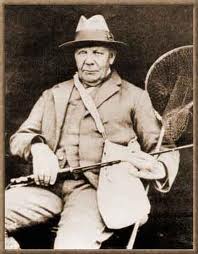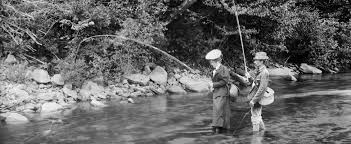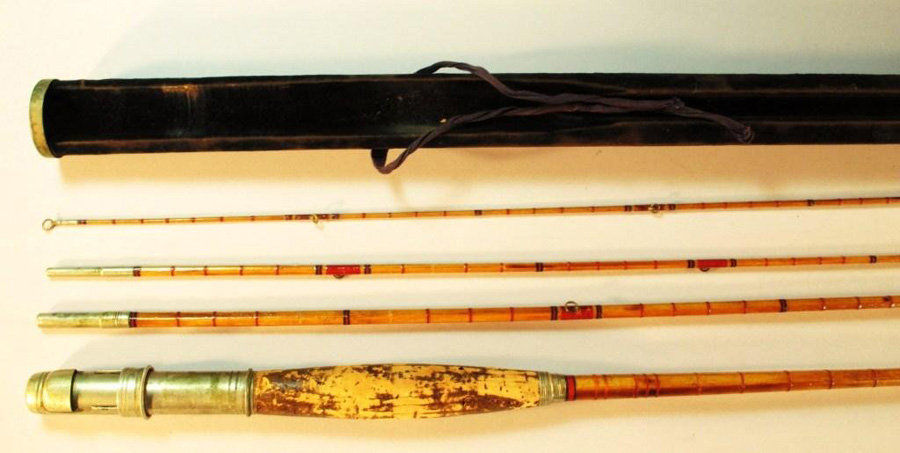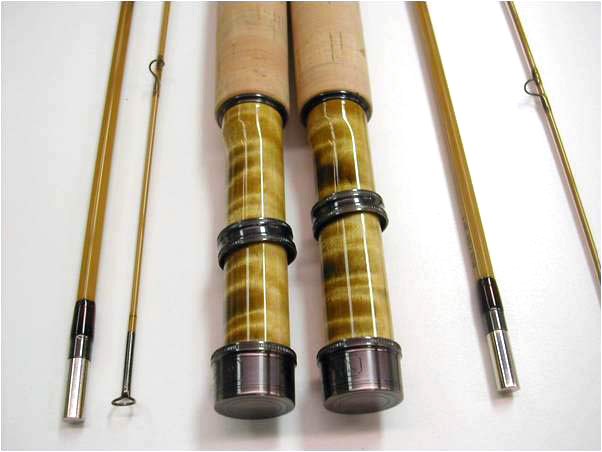
Well, one very reliable source has it that his favourite rod was none other than an American made H L Leonard bamboo that he called his WBR – the World’s Best Rod. This may qualify as no more than a mildly interesting bit of useless information, but I’m intrigued to know why an Englishman like Skues, the father of nymph fishing and a regular contributor to the London Fly-Fisher’s Club Journal (nothing more British than that) should end up owning an American fly rod? After all, Hardy Bros were making bamboo rods as early as 1880.

Theodore Gordon fishing with an unknown lady
Click in images to enlarge
Well The Complete Fly Fisherman, a wonderful reference book by John McDonald, gives us a clue. It reveals that Skues was in regular contact with Theodore Gordon, a reclusive American who many now regard as the father of dry fly fishing in the USA. In a letter from Gordon to Skues dated November 4, 1913, Gordon says, ‘You would enjoy fishing the 4 oz. Leonard …’ and later in a letter dated January 11, 1914, ‘…the beauty of the (Leonard) 4 oz. is in its delicate delivery of small flies…’ And Gordon goes on to tell Skues that the consummate excellence of Leonard rods was in the quality of the cane used in their making.

A Leonard from the time of Skues
So the question is, did Theodore Gordon convince Skues of the advantages of owning a Leonard over a British made bamboo?
Well the Fly-Fisher’s Journal, volume 3, No. 8, 1917-18, may give us the answer. In an article in that journal Skues has much to say about bamboo rods generally and in answering the question about the quality of a rod says that using the best material is important, as is ‘perfection in construction’, arguing that there must be no weak spot anywhere from butt to tip. He speaks of a rod needing ‘… a scientifically perfect gradation of taper from hand to the top ring’.
So far so good, but then tellingly Skues goes on to say, ‘I have handled a number of cheaper American rods that have come into the English market, and I have invariably been struck by the scientific character of their tapers. It is almost as conspicuous in the shoddiest of the cheap (American) rods as it is in those of the highest quality, and thus so many of them are a delight to handle. This perfection of taper involves not only the elimination of weaknesses, but also dispensing of all excesses of material. Thus these American split canes of all classes come to a finer point in the tip than do our English rods of corresponding length and without loss of power. And they run to less weight.’
So for my money three facts explain Skues’s fly rod preferences. The first is American makers were exporting bamboo rods to the British Isles back at the turn of the last century. The second is the tapers and lightness of these American rods was way ahead of the English products at the time and Leonard was evidently the best of all of them. And finally, I have little doubt that the regular correspondence between Gordon and Skues was indeed pivotal in Skues’s choice of an American Leonard rod, however contrary that might seem.
To clinch all this, Ernest Schwiebert’s book, Trout, refers in Volume 11 page 994 directly to Skues’s preference for Leonard rods and in 1974 the HL Leonard company made a rod to celebrate their proud association with Skues, a unique rod even by Leonard’s reputation for high specifications and quality. They designed it to suit the conditions on the Abbots Worthy section of the Itchen where Skues often fished his nymphs. It was an 8½ rod 3 weight with a slender taper designed to fish tippets of 7X.
That was then. What about today?

An Edward Barder 8’ 4 wt
Today it’s a different story. The world of bamboo rod making is as good – or as mediocre – in any of the many countries around the world these rods are now made depending entirely on the particular maker. And some of the best of them are made in the UK, rods from makers like Edward Barder and Tom Moran (Hardy’s) to name just two.

Tom Moran’s reincarnation of Hardy’s famous CC de France
The C.C. de France was made by Hardy between 1911 and 1961 and was their most successful bamboo fly rod ever. It was developed for the Casting Club of France as a short (7’) bamboo rod that had an extremely fast action. It threw a long line with great accuracy and was consequently ideal for use in casting tournaments.
The CC de France
So had GEM Skues lived today he would have been spoiled for choice.
See http://www.tomsutcliffe.co.za/fly-fishing/friend-s-articles/item/165-a-very-special-bamboo-rod-returns.html



